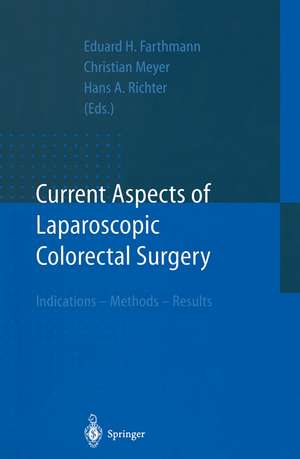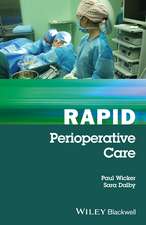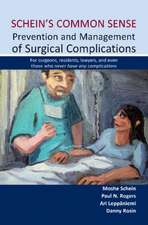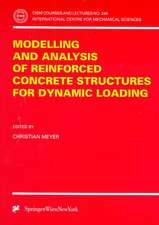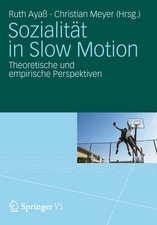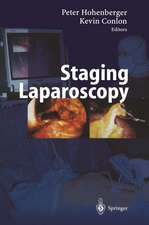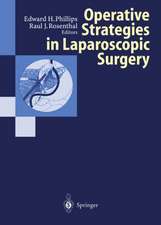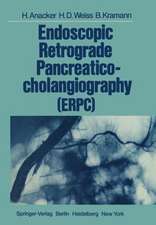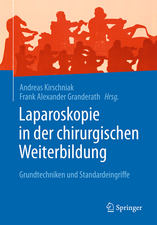Current Aspects of Laparoscopic Colorectal Surgery: Indications – Methods – Results
Editat de Eduard H. Farthmann, Christian Meyer, H.A. Richteren Limba Engleză Paperback – 26 sep 2011
Preț: 370.21 lei
Preț vechi: 389.70 lei
-5% Nou
Puncte Express: 555
Preț estimativ în valută:
70.85€ • 73.69$ • 58.49£
70.85€ • 73.69$ • 58.49£
Carte tipărită la comandă
Livrare economică 14-28 aprilie
Preluare comenzi: 021 569.72.76
Specificații
ISBN-13: 9783642643811
ISBN-10: 3642643817
Pagini: 324
Ilustrații: XV, 303 p. 57 illus., 15 illus. in color.
Dimensiuni: 155 x 235 x 17 mm
Greutate: 0.45 kg
Ediția:1997
Editura: Springer Berlin, Heidelberg
Colecția Springer
Locul publicării:Berlin, Heidelberg, Germany
ISBN-10: 3642643817
Pagini: 324
Ilustrații: XV, 303 p. 57 illus., 15 illus. in color.
Dimensiuni: 155 x 235 x 17 mm
Greutate: 0.45 kg
Ediția:1997
Editura: Springer Berlin, Heidelberg
Colecția Springer
Locul publicării:Berlin, Heidelberg, Germany
Public țintă
Professional/practitionerDescriere
This publication of the papers presented at the Workshop on Laparoscopic Colorectal Surgery that took place on 27-29 November 1995 in the European Surgical Institute in Norderstedt, Germany, is effectively a snapshot of the current state of knowledge in both the theory and the practice of minimally invasive colon surgery. This snapshot is a mosaic made up of the varied ex periences of individual surgeons. After a long period in which nothing much seemed to be happening, the recent growth in the use of minimally invasive surgery or video-controlled operative procedures in surgery of the abdominal and chest cavities has been unparalleled. More difficult operations have become increasingly possible as more and more new techniques have become available. Cholecystectomy should be regarded as the pacesetter for video-controlled procedures. Under defined conditions, it has now become the standard operation. Other operative procedures such as appendicectomy, hernior rhaphy, overs ewing of a perforated gastric or duodenal ulcer, vagotomy and fundoplication, operations on the spleen or adrenal, staging operations., and thoracic surgical procedures are becoming increasingly widely performed. Minimally invasive operations on the small and large bowel are currently still at the stage of individual reports.
Cuprins
I Standards.- Surgical Treatment of Chronic Inflammatory Bowel Disease.- Therapeutic Strategy in Sigmoid Diverticulitis: A Survey of German Surgical Departments.- Changing Standards in Our Practice of Rectal Cancer Surgery.- Standards in the Treatment of Colorectal Carcinoma: A German View.- Surgical Principles in the Treatment of Colorectal Cancer: A French View.- II Indications.- Laparoscopic Sigmoid Resection in Diverticulitis.- Indications for Laparoscopic Sigmoid Resection in Diverticulitis.- Laparoscopic Colorectal Surgery: Indications and Design of a Multicentre Study.- Laparoscopic Surgery in Crohn’s Disease.- Extracorporeal Resection of the Rectum in the Treatment of Prolapse Using the Stapler.- Rectal Prolapse: Rectopexy or Resection?.- Laparoscopic Surgery for Cancer of the Colon: A Pragmatic Approach.- Laparoscopic Operations in Colorectal Cancer.- Laparoscopic Resection of the Colon: Indications, Patient Selection, Results to Date.- Surgery for Rectal Cancer: Is It a Laparoscopic Procedure?.- Complications in Minimally Invasive Colon Surgery.- III Principles.- General Principles of Laparoscopic Colorectal Surgery.- Anesthetic and Monitoring Considerations in Patients Undergoing Laparoscopic Colectomy.- Assessment of Operative Difficulty and Postoperative Recovery in Laparoscopic Surgery of the Colon.- Cytological Examinations After Intraoperative Lavage in Colon Carcinoma Patients Undergoing Conventional and Laparoscopic Surgery.- Complexity of Laparoscopic Colon Procedures and Program Development.- IV Laparoscopic Surgical Techniques.- Laparoscopic Surgery of the Colon: Our Experience of 142 Cases.- Reconstruction After Low Auterior.- Laparoscopic Abdominoperineal Excision of the Rectum.- Laparoscopic Rectopexy.- Laparoscopic Intracorporeal End-to-End Colonic Anastomosis by Means of Individually Placed Staples.- Ultrasonography of Adhesions Prior to Laparoscopic Procedures After Previous Abdominal Operations.- V Results: Morbidity, Mortality, Long-Term Results.- Our Experience with Laparoscopic Colorectal Surgery.- Laparoscopic Rectosigmoid Resection for Carcinoma.- Laparoscopically Assisted Colorectal Surgery: A Review of 87 Cases.- Accelerated Recovery After Laparoscopic Colorectal Surgery for Cancer in Old Patients.- Laparoscopic Colectomy: Experience and Outcomes at the Minimally Invasive Surgical Training Institute in Baltimore.- The Need for Clinical Trials and Randomized Studies to Assess Laparoscopic Colectomy.- VI Advantages of the Laparoscopic Approach.- Laparoscopic Surgery for Carcinoma of the Colon: Does It Come Up to Standard?.- Laparoscopic Colorectal Surgery as Routine in a Community Hospital: Tactics and Results.- Open versus Laparoscopic Surgery in Colorectal Surgery: Results.- Laparoscopic Diagnosis, Staging and Follow-up of Colorectal Malignancies.- VII Summary of Discussioü and Opinion Poll.
Textul de pe ultima copertă
Laparoscopic video-assisted surgery has rapidly gained acceptance as a means of performing certain procedures on the gastrointestinal tract that were developed and standardized by the conventional, open approach. This is the case for cholecystectomy and, to a lesser degree, for operations on the gastro-oesophageal junction. In regard to colorectal disease, all major procedures have been shown to be technically feasible through a laparoscopic or laparoscopically assisted approach. It appears that the advantages of minor access surgery, such as less postoperative discomfort and shorter hospitalization, apply to colorectal operations as well. An area of dispute is the application of the laparoscopic approach to colorectal carcinoma. Therefore, any presentation of available data is of interest to workers in this field. This volume constitutes the proceedings of an expert meeting on this new and rapidly developing area of surgery.
